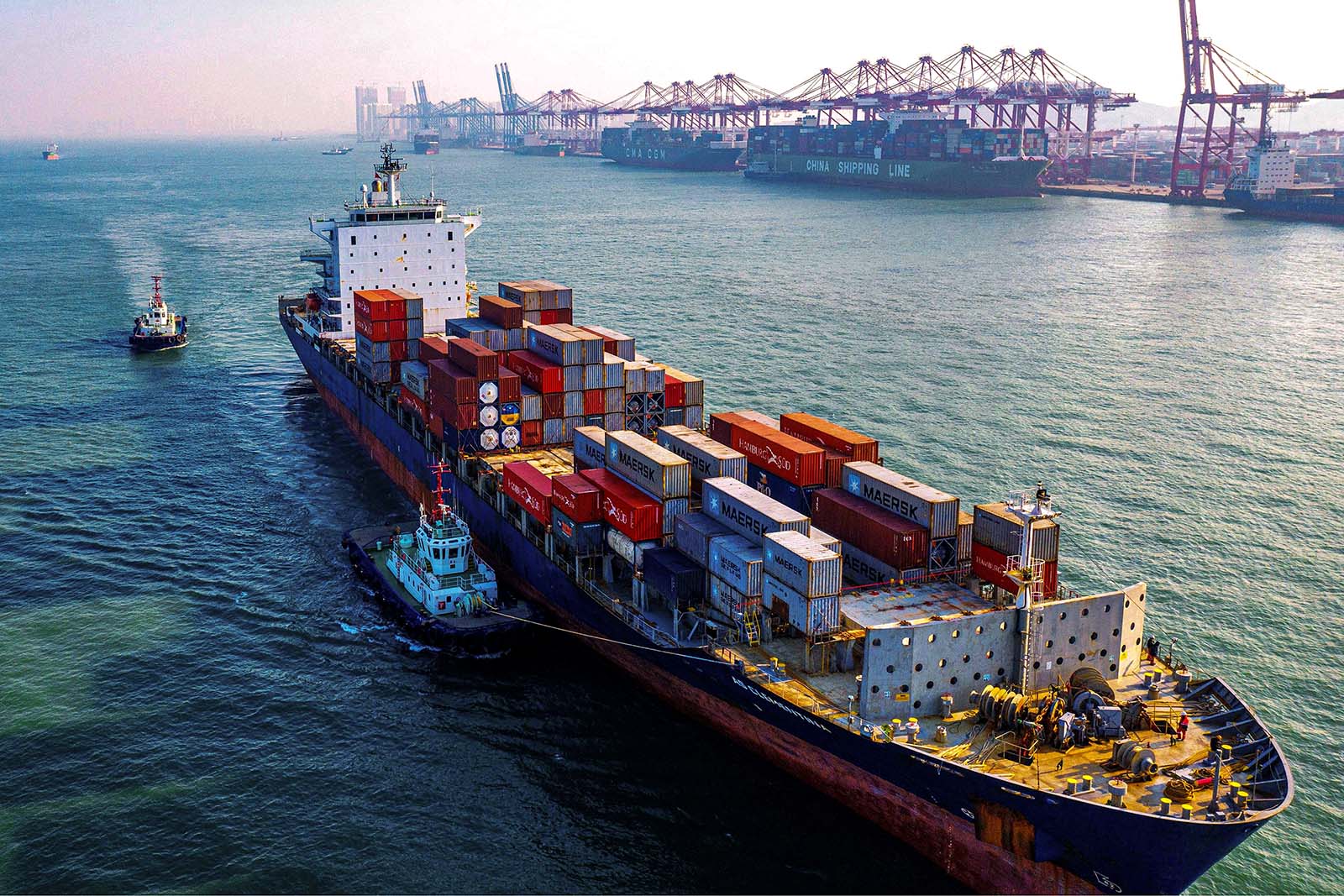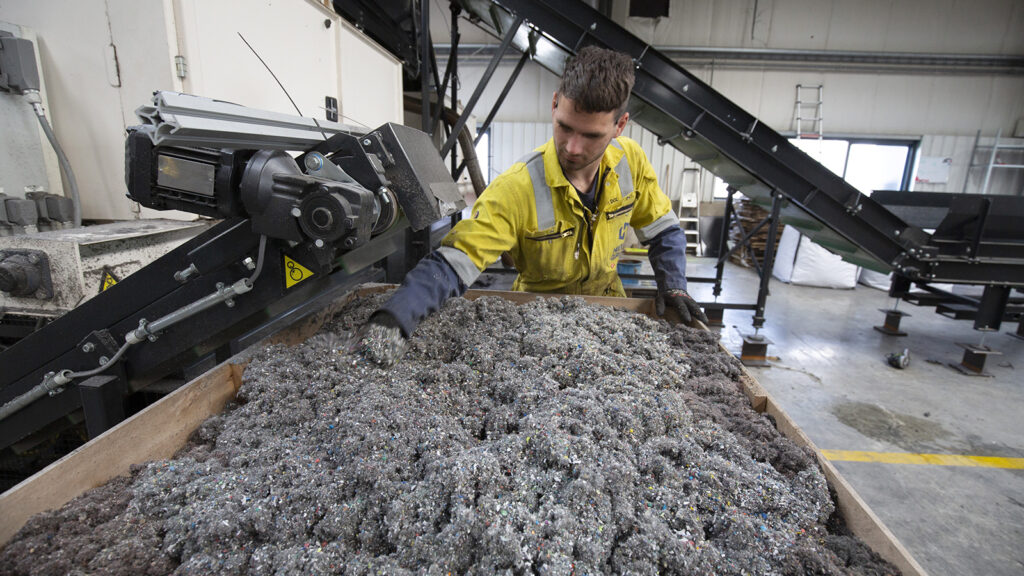What Does 2021 Hold for Global Trade?

A cargo ship loaded with containers makes its way from a port in Qingdao, China. The biggest open question regarding trade is: Will the Biden administration be able to achieve some sort of new grand bargain with China?
Photo: STR/AFP via Getty Images
How will the expected economic recovery impact trade? Will the Biden administration maintain current President Donald Trump’s tariffs on China? Has globalization been fundamentally altered by the pandemic? BRINK invited Nicolas Lamp, a global trade expert based at the Faculty of Law of Queen’s University Canada, to share his thoughts on what trends to expect in 2021.
LAMP: The concept that has come to the forefront in the pandemic is the idea of resilience. Initially, this took the form of an urge by countries to repatriate production so that they are never again in a situation like many were at the beginning of the pandemic, when they had to rely on foreign suppliers for certain key materials.
But resilience doesn’t necessarily mean that you repatriate; it could also mean that you try to diversify your suppliers, or that you engage in stockholding. If there is a movement toward greater reshoring or nearshoring of production, that would definitely have an impact on trade.
There are many who are skeptical that the supply chains can really be brought back on a significant scale. We should also keep in mind the longer-running trends already in place toward less trade, in particular with China becoming less focused on trade and more focused on domestic consumption, as well as the larger estrangement between China and the West.
The Impact of Regional Trade Deals
BRINK: Do you think we’re going to see more regionalization, with a higher proportion of trade occurring within regions rather than between them?
LAMP: I do think that we already have this; we have Factory Europe, Factory North America and Factory Asia. But some policies are strengthening the trend toward regionalization, for example, the USMCA in North America.
There was quite a bit of skepticism about whether the USMCA would really have an impact on supply chains, but it turns out that, as far as we can see, particularly here in Canada, the higher regional value content requirements for autos in the USMCA seem to be having an impact, as car manufacturers have announced major new investments in Ontario, and GM is even reopening an old plant.
Under NAFTA, 62.5% of a car had to be produced within the NAFTA countries in order for it to count as originating within NAFTA. The USMCA brought that up to 75%, so if you source major components of a car from China or anywhere else outside of the USMCA, you will not meet that regional value content requirement.
BRINK: What about the Regional Comprehensive Economic Partnership (RCEP) — are we going to see a similar pattern of regionalization in Asia?
LAMP: While the economic impact of RCEP remains a matter of debate, given the pre-existing FTAs among the parties, the adoption of common rules of origin and the provisions on regional cumulation are clearly a step toward greater integration in Asia, though it would be a bigger one if India were part of the agreement.
A key difference with the USMCA is that the USMCA was essentially an attempt to draw up the drawbridges toward the outside world, at least with respect to trade in autos and auto parts. You don’t have an equivalent to that in the RCEP.
BRINK: What about the Trans Pacific Partnership (TPP)?
LAMP: We’re in the interesting situation in which the U.S. may try to rejoin the TPP and, at the same time, China has made noises about being willing to join the TPP.
One may question whether China is serious about this, because of some of the provisions in the TPP, especially when it comes to state-owned enterprises, may be hard for it to swallow. However, the real underlying question is whether there’s going to be some sort of grand bargain between China and the United States, which would be necessary for any new agreement to accommodate these two great powers.
Such a bargain could take the form of both of them joining the TPP. It could take place in the form of a bilateral “Phase Two” agreement. Or it could be reflected in renewed engagement in the WTO.
The Trump administration hiking tariffs gave the U.S. leverage. The tariffs are illegal under WTO law, so the leverage can’t be used in a WTO negotiation, but it could potentially be used to get a new grand bargain with China.
The Move to Zero Emissions and Global Trade
BRINK: There’s a lot of talk of the possibility of peak oil and moving toward zero emissions. Do you see that having a significant impact on value chains and global trade?
LAMP: That’s definitely possible. We’ve talked about border tax adjustments for a long time, but it’s not really been implemented on any scale by any major trading country. However, the European Union seems to be finally getting serious about their carbon border tax adjustment. And Canada just announced that it wants to hike the carbon tax to $170 per ton by 2030, so the issue is bound to become more politically important for Canada as well.
The concern for any country that implements an economically significant price on carbon is carbon leakage: the possibility that companies will move their production to other countries where they face a lower cost for the carbon.
To stem carbon leakage, countries can levy the equivalent of the carbon tax on imports at the border. While this can be done legally, it could still spark considerable trade friction, if only because it raises questions about the equivalency of what the different countries are doing on climate change.
From a climate perspective, it will be good to have these conversations about different systems and whether they impose an equivalent cost on carbon. If large markets move ahead with a carbon price, and then impose it on imports as well, that could have a spillover effect on other countries, which would be very positive from a climate perspective.
How Will President-Elect Biden Treat President Trump’s Trade Legacy?
BRINK: If you were to predict a surprise in the global trading system in 2021 that people are not thinking enough about, what would you have in mind?
LAMP: What’s really going to be interesting to see is the reassessment of President Trump’s trade legacy that’s going to happen.
At the moment, President Trump is still seen mostly as a wrecking-ball, but over time, I think we will realize that the effect of some of what he did was more like a catalyst, where he released longstanding pressures that have now broken into the open and that can’t be put back in the box. That is particularly the case for the relationship with China.
The relationship with China has at least three important aspects that we need to distinguish: the first is the national security dimension, on which there is broad bipartisan agreement in the United States. Those security concerns are going to be the same for the Biden administration as they were for the Trump administration. I therefore believe that we are going to see some limited decoupling continue in the relationship between the U.S. and China.
The second dimension is that of economic and technological competition. This dimension is hard to disentangle from the security dimension in many ways, but some actions of the Trump administration seem designed to stymie China’s economic rise and technological progress even in ways that would not be strictly necessary from a security perspective.
There are some signs that the Biden administration will take a less aggressive path and put more emphasis on strengthening the United States’ own capacity than on holding China down.
Where Is the US/China Relationship Heading?
The third dimension, which hasn’t gotten quite as much attention, is the legal relationship between the U.S. and China as it is embodied in the WTO. The problem is that China still has much higher bound tariffs in the WTO than the U.S. The average bound tariff for China is 10%, for the U.S., it’s 3.4%. There’s really no way for the U.S. to bring China tariffs down to its level in a regular WTO negotiation, because it simply does not have enough bargaining ammunition.
What the Trump administration did by hiking all these tariffs regardless of WTO rules was to give that U.S. leverage. The tariffs are illegal under WTO law, so the leverage can’t be used in a regular WTO negotiation, but it could potentially be used somehow to get a new grand bargain with China, perhaps following the climate model, where former President Obama and President Xi Jinping came to an agreement bilaterally about how they would go forward, which then allowed the Paris Agreement to come together. Something similar is needed in the trade sphere.
For me personally, that is the biggest open question: Will the Biden administration be able to use all the ammunition that the Trump administration has given it, including the tariffs that are still in place, to achieve some sort of new grand bargain with China?






